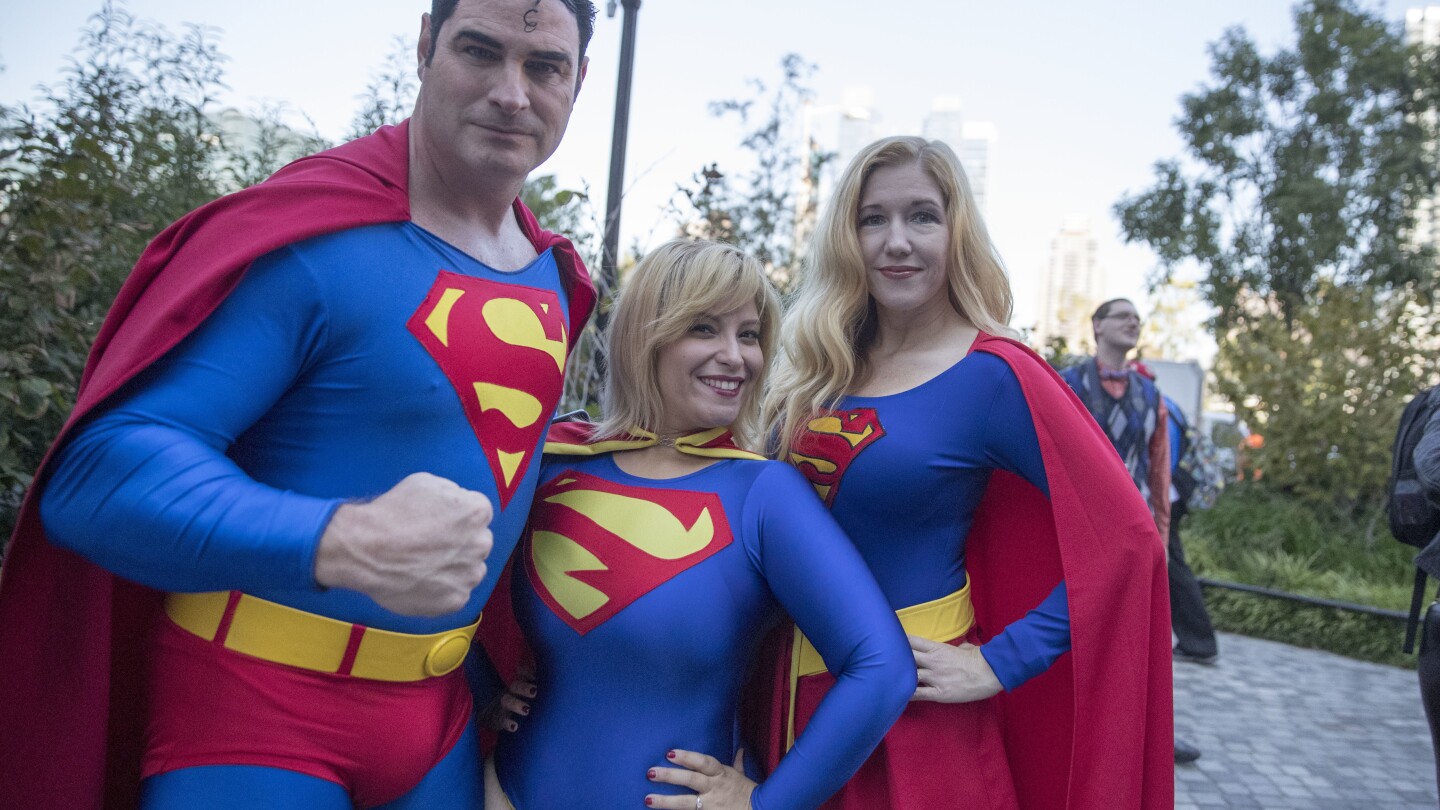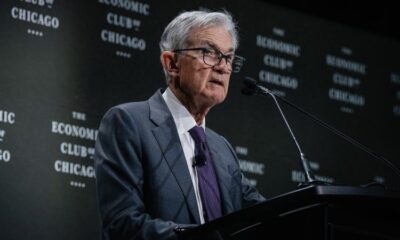Lifestyle
Mental health leaves are increasingly common for US workers

NEW YORK (AP) — Her first panic attack came at a company-wide meeting, right before her scheduled presentation. Carolina Lasso had given many similar talks about her marketing team’s accomplishments. When her name was called this time, she couldn’t speak.
“I felt a knot in my throat,” Lasso said. “My head, it felt like it was inside a bubble. I couldn’t hear, I couldn’t see, and it felt like an eternity. It was just a few seconds, but it was so profound, and in a way earth-shattering to me.”
Lasso was struggling after a cross-country move followed by a divorce. Her boss suggested a mental health leave, a possibility she didn’t know existed. She worried whether taking time off would affect how her team viewed her or cost her a future promotion, but in the end she did.
“I’m thankful for that opportunity to take the time to heal,” Lasso, 43, said. “Many people feel guilty when they take a leave of absence when it’s mental health-related. … There is some extra weight that we carry on our shoulders, as if it had been our fault.”
Despite a fear of repercussions, more adults are recognizing that stepping back from work to deal with emotional burdens or psychological conditions that get in the way of their lives is a necessary choice, one that a growing number of employers recognize.
ComPsych Corp., a provider of employee mental health programs and absence management services, encourages its business clients to make the well-being of workers a priority before individuals get to a breaking point while also having processes in place for those who require leaves of absence.
This article is part of AP’s Be Well coverage, focusing on wellness, fitness, diet and mental health. Read more Be Well.
“Since the start of the COVID-19 pandemic, collectively we’ve just been in this constant state of turmoil,” Jennifer Birdsall, the senior clinical director at ComPysch, said. “We just have had this barrage of change and uncertainty.”
Depression, anxiety and adjustment disorder, which involves excessive reactions to stress, were the top three diagnoses of employees who took mental health leaves in the past two years among clients of Alight, a Chicago-based technology company which administers leaves and benefits for large employers.
Structuring a leave
A mental health leave can last weeks or months. In some cases, workers get approval to work a reduced schedule or to take short periods of time off when needed, using an approach called “intermittent leave.”
At most U.S. organizations with 50 or more employees, people can request leaves through the Family and Medical Leave Act. The federal law entitles workers with serious health conditions to paid or unpaid leaves of up to 12 weeks, depending on state and local laws.
Some employers require people to use sick days or accumulated vacation days to continue receiving a paycheck while out. For longer leaves, workers can access short-term disability plans, if their employer offers one.
Lasso’s leave lasted six months, and included therapy and travel to India for additional treatment. She returned to her job but decided after a year to leave for good. She later launched a business to train people on fostering a more humane work culture.
A mental health leave is “not only OK, but it can really unlock new possibilities once we have the time to do the work — therapy, medication, whatever it is — and have enough distance from work to be able to reconnect with ourselves,” Lasso said.
Talking openly about struggles
A social stigma around mental health challenges causes many people to avoid seeking treatment or requesting a leave of absence. Newton Cheng, director of health and performance at Google, hopes to change that by sharing his own struggles.
His first self-disclosure happened during the pandemic, when a senior manager invited employees at a meeting to share how they were doing. When it was his turn, Cheng started crying.
He explained he was struggling to live up to his expectations of himself as a father and didn’t know how to turn things around.
“It was just totally horrifying to me because, one, I had just cried in front of my coworkers and I was definitely taught as a professional — and as a man — you do not do that,” Cheng recalled. “And then two, I had never really articulated and said out loud those words. I hadn’t even allowed myself to think that. But now they’re out there and I had to face them.”
Colleagues responded by relaying their own struggles, but Cheng’s difficulties continued. By February 2021, he couldn’t get out of bed because he felt paralyzed by dread, he said. A therapist said he was showing symptoms of major depression and anxiety.
“I just realized, ‘I’m struggling a lot and this goes pretty deep. I don’t think I can keep just putting duct tape on this. I probably need to take some leave,’” Cheng recalled.
Hoping his decision would benefit others, he announced to 200 people at a conference that he planned to take mental health leave. Instead of derailing the gathering as he feared, his honesty inspired fellow conference attendees to open up.
“It was like a fireworks show,” Cheng said. “They’re like, ‘Wow, I can’t believe he did that.’ Then they forgot about me. But the tone was set. It was like ’Oh, this is what we’re doing. Let me talk about what’s going on with me, too.’”
Take the time you need
While balancing classes and a full-time job during her last year of college, Rosalie Mae began struggling to get out of bed and crying uncontrollably. Yet she felt like she had “to keep it together” to avoid burdening her colleagues at the University of Utah bookstore, where Mae worked as an accounting clerk.
Then she found herself calling a suicide hotline. “Once it reached that point, I knew, especially at the urging of my husband, we need to do something more,” Mae, 24, said.
In her case, that meant taking a five-week work leave to put her own health and well-being first. She recommends the same for others who find themselves in a similar position.
“Taking a mental health leave is not necessarily a cure-all, but it is important to give yourself a break and allow yourself to regroup, make a plan of how to proceed and take the steps to work towards feeling better,” Mae said.
Telling managers and colleagues
Before broaching the subject of a mental health leave with a manager, consider the workplace culture and the strength of your professional relationships, Cheng said. He recalls saying, “For my health and well-being, and the sake of my family and what’s best for the business, the least risky thing for me to do is to go on leave soon.”
Individuals who suspect an unsympathetic reception can simply say, “I need to go on medical leave. I need time to recover,” he advised.
There’s also no legal or ethical requirement to tell everyone you work with the nature of your leave.
“Your coworkers don’t need to know why,” said Seth Turner, co-founder of AbsenceSoft, a leave and accommodation management solutions provider. “They just need to know, ‘I’m going to be here at this time, and I’m going to be gone at this time, and I’ll be back.’”
___
Have you overcome an obstacle or made a profound change in your work? Send your questions and story ideas to [email protected]. Follow AP’s Be Well coverage, focusing on wellness, fitness, diet and mental health at https://apnews.com/hub/be-well.
Lifestyle
The 250th anniversary of the Battles of Lexington and Concord opens debate over US independence
NEW YORK (AP) — The American Revolution began 250 years ago, in a blast of gunshot and a trail of colonial spin.
Starting with Saturday’s anniversary of the Battles of Lexington and Concord, the country will look back to its war of independence and ask where its legacy stands today.
The semiquincentennial comes as President Donald Trump, the scholarly community and others divide over whether to have a yearlong party leading up to July 4, 2026, as Trump has called for, or to balance any celebrations with questions about women, the enslaved and Indigenous people and what their stories reveal.
The history of Lexington and Concord in Massachusetts is half-known, the myth deeply rooted.
What exactly happened at Lexington and Concord?
Reenactors may with confidence tell us that hundreds of British troops marched from Boston in the early morning of April 19, 1775, and gathered about 14 miles (22.5 kilometers) northwest on Lexington’s town green.
Firsthand witnesses remembered some British officers yelled, “Thrown down your arms, ye villains, ye rebels!” and that amid the chaos a shot was heard, followed by “scattered fire” from the British. The battle turned so fierce that the area reeked of burning powder. By day’s end, the fighting had continued around 7 miles (11 kilometers) west to Concord and some 250 British and 95 colonists were killed or wounded.
But no one has learned who fired first, or why. And the revolution itself was initially less a revolution than a demand for better terms.
Woody Holton, a professor of early American history at the University of South Carolina, says most scholars agree the rebels of April 1775 weren’t looking to leave the empire, but to repair their relationship with King George III and go back to the days preceding the Stamp Act, the Tea Act and other disputes of the previous decade.
“The colonists only wanted to turn back the clock to 1763,” he said.
Stacy Schiff, a Pulitzer Prize winning historian whose books include biographies of Benjamin Franklin and Samuel Adams, said Lexington and Concord “galvanized opinion precisely as the Massachusetts men hoped it would, though still it would be a long road to a vote for independence, which Adams felt should have been declared on 20 April 1775.”
But at the time, Schiff added, “It did not seem possible that a mother country and her colony had actually come to blows.”
A fight for the ages
The rebels had already believed their cause greater than a disagreement between subjects and rulers. Well before the turning points of 1776, before the Declaration of Independence or Thomas Paine’s boast that “We have it in our power to begin the world over again,” they cast themselves in a drama for the ages.
The so-called Suffolk Resolves of 1774, drafted by civic leaders of Suffolk County, Massachusetts, prayed for a life “unfettered by power, unclogged with shackles,” a fight that would determine the “fate of this new world, and of unborn millions.”
The revolution was an ongoing story of surprise and improvisation. Military historian Rick Atkinson, whose “The Fate of the Day” is the second of a planned trilogy on the war, called Lexington and Concord “a clear win for the home team,” if only because the British hadn’t expected such impassioned resistance from the colony’s militia.
The British, ever underestimating those whom King George regarded as a “deluded and unhappy multitude,” would be knocked back again when the rebels promptly framed and transmitted a narrative blaming the royal forces.
“Once shots were fired in Lexington, Samuel Adams and Joseph Warren did all in their power to collect statements from witnesses and to circulate them quickly; it was essential that the colonies, and the world, understand who had fired first,” Schiff said. “Adams was convinced that the Lexington skirmish would be ‘famed in the history of this country.’ He knocked himself out to make clear who the aggressors had been.”
A country still in progress
Neither side imagined a war lasting eight years, or had confidence in what kind of country would be born out of it. The founders united in their quest for self-government but differed how to actually govern, and whether self-government could even last.
Americans have never stopped debating the balance of powers, the rules of enfranchisement or how widely to apply the exhortation, “All men are created equal.”
“I think it’s important to remember that the language of the founders was aspirational. The idea that it was self-evident all men were created equal was preposterous at a time when hundreds of thousands were enslaved,” said Atkinson, who cites the 20th-century poet Archibald MacLeish’s contention that “democracy is never a thing done.”
“I don’t think the founders had any sense of a country that some day would have 330 million people,” Atkinson said. “Our country is an unfinished project and likely always will be.”
Lifestyle
Sweets from the sky! A helicopter marshmallow drop thrills kids in suburban Detroit

ROYAL OAK, Mich. (AP) — It’s spring in Detroit — warm weather, a few clouds, and a 100% chance of marshmallow downpours.
The source? A helicopter zooming above the green lawn of Worden Park on Friday, unloading sack-fulls of fluffy treats for hundreds of kids waiting eagerly below, some clutching colorful baskets or wearing rabbit ears.
The children cheered and pointed as the helicopter clattered by on its way to the drop zone. Volunteers in yellow vests made sure kids didn’t rush in and start grabbing marshmallows until after the deluge was complete.
For anyone worried about hygiene, don’t fret. The annual Great Marshmallow Drop isn’t about eating the marshmallows — kids could exchange them for a prize bag that included a water park pass and a kite.
The marshmallow drop has been held for over three decades in the Detroit suburb of Royal Oak, Michigan, hosted by Oakland County Parks.
One toddler, Georgia Mason, had no difficulty procuring a marshmallow at her first drop, her dad Matt said.
“Probably the most exciting part was seeing the helicopters. But once we saw the marshmallows drop, we got really excited,” Matt Mason said.
“And, yeah, we joined the melee,” he said, “We managed to get one pretty easy.”
Organizers said 15,000 marshmallows were dropped in all.
The helicopter made four passes, dropping marshmallows for kids in three age categories: 4-year-olds and younger, 5-7-year-olds, and those ages 8 to 12. A drop for kids of all ages with disabilities came later in the day.
“We do it because it’s great for community engagement,” Oakland County recreation program supervisor Melissa Nawrocki said.
“The kids love it,” she continued. “The looks on their faces as they’re picking up their marshmallow and turning in the marshmallow for prizes is great.”
Lifestyle
AP report: Superman comics have religious and moral themes

Superman comics are not overtly religious. Yet faith and morality have been baked into this superhero character who was born Kryptonian, raised Methodist and created by two young Jewish men in 1930s Cleveland.
Superman’s character has been portrayed in the mold of Christ and Moses given how he constantly upholds the ideals of self-sacrifice, powerful leadership and compassion. While scholars, comic book writers and fans alike are struck by the religious undertones in Superman comics, they all agree that what sets Superman apart is his ability to bring hope in a hopeless world.
Superman Day and the ‘Superman’ summer movie release
Friday (April 18) marks the 87th anniversary of the original superhero’s birth. It also is the date Superman made his debut in an Action Comics issue.
There is much excitement in the Superman fanverse this year because of the much-anticipated ‘Superman’ movie directed by James Gunn, starring David Corenswet, the first Jewish actor to play Superman in a major film.
On his Instagram page on April 18, 2024, Gunn shared a photo of himself, Corenswet and Rachel Brosnahan who plays Lois Lane in the upcoming film, reading among several comic books, a reproduction of Action Comics #1 — the very first one featuring the Man of Steel.
In his Instagram post, Gunn also paid tribute to the superhero, saying: “He gave us someone to believe in, not because of his great physical power, but because of his character and determination to do right no matter what.”
Gunn’s film promises a return to a version of a vulnerable Superman who is rooted in values espoused by most faiths — goodness, compassion and hope.
Superman’s Jewish roots
Samantha Baskind, professor of art history at Cleveland State University, is Jewish and sees numerous parallels between Superman’s origin story and the history of Jews.
She says Superman’s solitary flight from Krypton in a small spacecraft is reminiscent of how Moses’ mother placed him in a papyrus basket and left him on the Nile, seeing it as his best chance of survival.
Some also compare Superman’s backstory to the Kindertransport, she said, referring to a humanitarian rescue program that transported nearly 10,000 children, mostly Jewish, from Nazi-controlled territories to Great Britain in 1938 and 1939. In Superman’s Kryptonian name, Kal-El, chosen by his original Jewish creators Jerry Siegel and Joe Shuster, the “El” in Hebrew connotes God.
“There’s also the thinking that Siegel and Shuster created Superman because they were these two, skinny, young Jewish men who couldn’t go out and fight Hitler, but Superman fought Nazis on the cover of their comic books,” Baskind said.
In some early editions, Superman held Hitler by his Nazi uniform as he begged for mercy.
Strong appeal to diverse groups
Superman is relatable to diverse populations regardless of religion, race or ethnicity.
Gene Luen Yang, who has written several Superman comics, sees his own experience as a Chinese American mirrored in Superman’s story — caught between two worlds and two cultures. Yang says he had one name at home and another at school, just like Superman. So, even though he is a practicing Catholic, Yang says he relates more to Superman’s Jewish roots.
Despite the religious undertones, Superman also appeals to those who are religiously unaffiliated, said Dan Clanton, professor of religious studies at Doane University in Nebraska, adding that the superhero’s story “truly encapsulates American civil religion.”
Neal Bailey, a longtime contributor to Superman Homepage, a fan site, is an atheist. He views Superman as a “philosophical pragmatist” with the ability to solve the most complex problems with the least amount of harm.
“He actually goes beyond religion to see our commonalities,” Bailey said. “Superman wouldn’t care about people’s religious beliefs. He would care more about whether they are living up to their human potential.”
Superman inspires humans to do better
Grant Morrison, one of the best-known writers of Superman comic books, said in a 2008 interview that humans become what they imitate, which is why he made Superman an inspirational character.
Superheroes have received less-than-flattering treatment in recent films and television shows. For example, in “The Boys,” a comic book turned Amazon Prime series, the Superman-like character, Homelander, is a government-sponsored hero whose smiling exterior conceals the heart of a sadist. Gunn’s Superman is expected to change that trajectory with a superhero who will reinforce the character’s core value of preserving life at any cost.
An altruistic view of Superman can be found in the recently concluded “Superman & Lois” television series on the CW Network in which after defeating Lex Luthor in a final battle, the couple settles down in a small town and starts a foundation to help others.
“I didn’t just want to be a hero that saves people,” the Superman character played by Tyler Hoechlin says in an epilogue to the series. “I wanted to connect with them. To change their lives for the better.”
___
Associated Press religion coverage receives support through the AP’s collaboration with The Conversation US, with funding from Lilly Endowment Inc. The AP is solely responsible for this content.
-

 Conflict Zones2 days ago
Conflict Zones2 days agoHaiti in ‘free fall’ as violence escalates, rights group warns | Armed Groups News
-

 Sports2 days ago
Sports2 days agoJu Wenjun: Chinese grandmaster makes history by winning fifth Women’s World Chess Championship
-

 Sports2 days ago
Sports2 days agoAaron Boupendza: 28-year-old former MLS player dies after falling from 11th floor balcony in China
-

 Lifestyle2 days ago
Lifestyle2 days agoLook inside Maine’s ‘Sistine Chapel’ with 70-year-old frescoes
-

 Europe2 days ago
Europe2 days agoTrump blasts Fed Chair Powell, saying his ‘termination cannot come fast enough’
-

 Sports2 days ago
Sports2 days agoSerena Williams says she would have received a 20-year ban for a similar doping offense to Jannik Sinner
-

 Education21 hours ago
Education21 hours agoHarvard’s battle with the Trump administration is creating a thorny financial situation
-

 Education2 days ago
Education2 days agoTrump admin threatens to stop Harvard from enrolling foreign students




